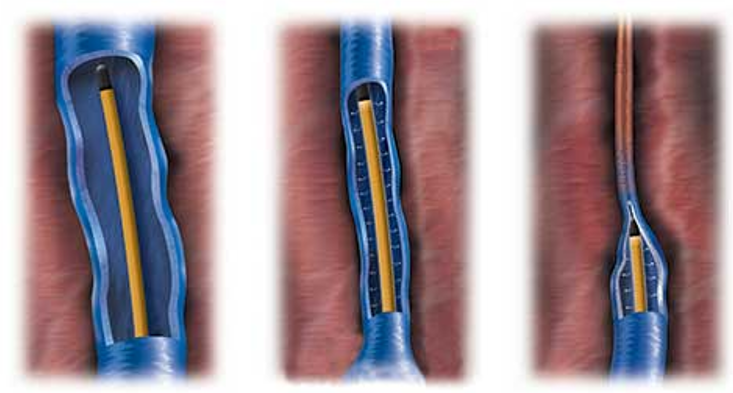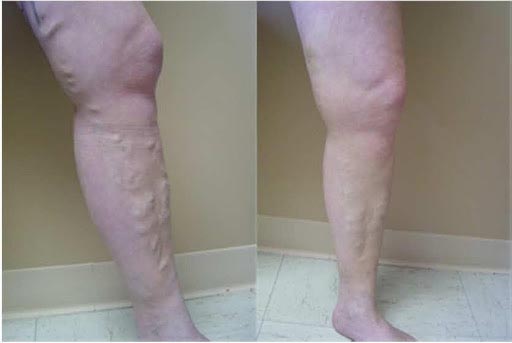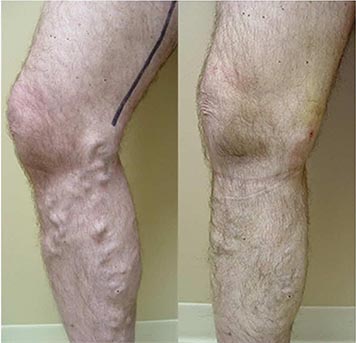Varicose Veins
Treatment for Chronic Venous Insufficiency
ClosureFastTM (VNUS) Procedure
The procedure, previously known as the VNUS Closure Procedure, offers patients an efficient, non-surgical alternative for treating varicose veins to improve the skins' appearance and reduce health risks related to large varicose veins. The procedure utilizes radiofrequency (RF) energy to heat and contract the collagen found inside the vein walls, causing the vein to collapse and seal shut.
Disposable catheter is inserted. The vein will collapse and close as the controlled heat catheter is withdrawn.

Advantages and Benefits of the procedure include:
- Outpatient procedure
- Minimal downtime; normal activity can be resumed within 1-2 days
- Minimally-invasive; not an open surgical procedure
- Little to no scarring
- Long-lasting relief from symptoms
Extensive clinical tests involving thousands of patients throughout the United States and Europe demonstrated that the procedure is effective in occluding (closing) veins and reducing patient symptoms. In addition, published studies have shown that at 12 and 24 months following the procedure, over 90% of treated veins remained reflux free.

Before and After ClosureFastTM Procedure
Using ultrasound, your physician will position the catheter into the diseased vein through a small opening in the skin. The tiny radiofrequency powered catheter delivers heat to the vein wall. After sealing the vein, blood flow redirects to healthy veins, thus reducing or eliminating the appearance of enlarged, diseased veins. The procedure is performed on an outpatient basis and typically takes about 45 - 60 minutes. Local anaesthesia is used for patient comfort. In some cases, this procedure is performed in conjunction with Ultrasound Guided Sclerotherapy.

Venefit Procedure for Varicose Veins
Following the procedure, a simple bandage is placed over the insertion site, and additional compression may be provided to aid healing. You are encouraged to walk and refrain from extended standing and strenuous activities for a period of time. Patients who undergo the procedure typically resume normal activities within a day.
How is the Venefit procedure different from vein stripping?
Vein stripping is an invasive surgical procedure that requires removing the vein through an incision during surgery. Vein stripping is typically performed in the operating room under full anaesthesia. The ClosureFastlM Procedure, on the other hand, does not require surgery or the removal of the vein. Instead, the vein is left in place and is closed using a special catheter inserted through a very small puncture. Because the procedure is less invasive, recovery time is shortened from a few weeks on average for vein stripping to about one day for the procedure. Additionally, the procedure is performed on an outpatient basis using local anaesthesia.
How to prepare for Radio Frequency Ablation done in consultation rooms:
- Wear loose-fitting clothing, especially loose-fitting pants
- Eat and drink normally beforehand
- Keep warm
- Have someone to bring you to and pick you up from the consultation rooms after the procedure
- If you are on medical aid, make sure you have the authorization number with you
- Make sure you let the doctors' offices know if you received authorization for the procedure
How to prepare for Radio Frequency Ablation done in hospital:
- Do not eat or drink anything (not even water) from the night before surgery
- Be at the hospital at the allocated time
- If you are on medical aid, make sure you have the authorization number with you
- Be sure to book your bed in the hospital beforehand- it is a day case, but you will need a bed to recover after the surgery
- Have someone bring you to and pick you up from the hospital after your procedure
- Make sure you let the doctor's offices know if you received authorization for the procedure
Aftercare tips for Radio Frequency Ablation:
- A day after the procedure, return to normal activities
- Elevate the leg or legs at frequent intervals for at least 30 minutes per day
- Do not sit or stand for prolonged periods of time - walking is good for the recovery
- Refrain from any heavy lifting or strenuous activity for 3 to 5 days after the procedure
- Wear the compression bandages that have been put on the legs after the procedure for 72 hours, after the 72 hours, wear the compression stockings for at least four weeks ( it is advised to wear the compression stockings as much as possible even after the four weeks of mandatory wearing)
- Make an appointment for 72 hours after the procedure to have a follow up done.
Complications:
Patient satisfaction is our top priority; we do everything possible to ensure you're a healthy, satisfied patient. You may be disappointed if the results are not what you expected, something that can easily happen if you do not fully understand the nature or the possible outcomes of the procedure. This can be minimized with thorough communication with your family and myself.
This brings us to the topic of complications. No matter how small or insignificant, all operations have possible complications, both from the surgical and the anaesthetic points of view. In this case, you will be receiving a calmative like Ativan. In most cases, you will not receive general anaesthesia.
Some complications are general to all surgical procedures, and others are quite specific to the type of operation you will undergo. Your chances of getting a particular complication vary according to your health, age, type of procedure and many other factors. An excellent example of this is wound infections.
Depending on multiple variables, your chance of developing a superficial wound infection can be less than one percent, or could be as high as about 40%.
If you know beforehand that this specific type of operation has a high probability of a certain complication, it will be much easier for you to accept it and work with the surgical team to resolve the problem as soon as possible. If you are not warned beforehand, it will be much more difficult to accept, and dissatisfaction can occur.
The nature of the procedure with its predictable outcome will be explained to you before the operation, as will possible complications. Obviously, not all possible complications can be discussed, but general complications specific to your type of procedure will be explained to you.
Make sure you understand these, and do not hesitate to ask questions if something is unclear. You will be asked to sign an "informed consent" document, which implies that you know what procedure will be performed, what outcome can be expected and what risks are involved with the procedure.
The term "informed consent" is challenging because, due to the technicality of modern surgery, it is sometimes difficult to fully explain to a person what effects a particular operation will have. Certain people prefer to know less than others what will happen during surgery and the effects, so here you can help guide the team by expressing your wishes and asking questions where things are unclear.
Pain:
Most patients report feeling little, if any, pain during the procedure. You will be given a local anaesthetic to numb the treatment area.
Bleeding:
Post-operative bleeding is luckily a very rare occurrence and is rarely of major concern. However, certain drugs like aspirin, certain pain medicines, and warfarin can increase your risk of post-operative bleeding. Before the operation, a complete list of all your usual medications should be given to the surgical team.
Infection:
Although everything possible will be done to minimize the risk of wound infections, it is a fact that infection is always a possibility after an operation. In most operations, the risk is very small (<5%).
Deep vein thrombosis:
Deep vein thrombosis (DVT), a blood clot in the veins of your legs, and its more serious partner, PE (pulmonary embolism) or clots of blood going up and lodging in the lungs) is also a risk after surgery. The surgical team will assess your risk of developing a DVT versus your risk of bleeding after operation and will sometimes prescribe measures and even medications and injections to minimize the chances of clots forming in your legs. This can include the use of tight leg stockings or even pneumatic compression stockings, and although sometimes uncomfortable, it should be used as prescribed, as it is for your benefit. Again, you can help minimize the risk of clots forming, like moving your feet a lot, walking around as soon as possible after the operation, not smoking, not lying in bed, or sitting in chairs too long after the procedure.

